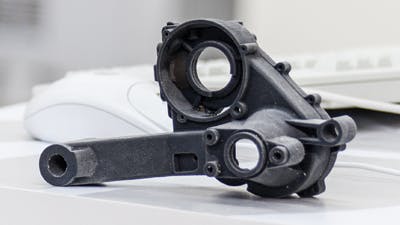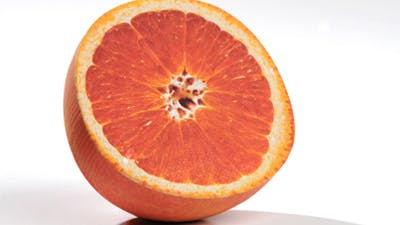
Comparing 3D Printing Processes
There are a number of 3D printing processes out there, each with their own strengths and weaknesses. Some are ideal for functional prototypes, whereas others are best suited for end-use parts or scale models.

There are a number of 3D printing processes out there, each with their own strengths and weaknesses. Some are ideal for functional prototypes, whereas others are best suited for end-use parts or scale models. The primary differences are build material, material distribution method, and binding technique. How do you know which process to use?
Of the six processes detailed below, Xometry offers Material Jetting (PolyJet 3D), Fused Deposition Modeling (FDM) and Directed Energy Deposition in nylon (SLS), stainless steel and aluminum (DMLS), photopolymerization in Stereolithography (SLA), and Binder Jetting. We also offer, HP Multi Jet Fusion and Carbon DLS.
Build Material: Photopolymer
Material Distribution Method: Jet
Binding Technique: Light (UV lamp)
Material jetting (also known as PolyJet 3D) is a process that uses a liquid build material that will solidify when exposed to a certain wavelength of light. In this process, material is selectively jetted (much like a document printer jets ink) and then instantly cured by a UV lamp. This offers some advantages, most notably the ability to create models with multiple materials. Instead of having to use only one type of material resting in a vat, you can jet different ones where you need them. These materials not only differ in color, but in mechanical property.
Build Material: Powder
Material Distribution Method: Bed
Binding Technique: Heat (laser or welding)
This is a fun one that can make some really tough parts. Powdered material is spread out layer by layer onto a bed. The term “bed” comes from the point that the power is evenly spread across the entire bed before only portions of it are joined. The powder will be selectively joined through a laser that sinters the beads together. Once a layer has been hit by the laser, another layer will be spread on top of it. The process is repeated, with each layer selectively joining to the one below it. This results in a powder cube with a solid part contained inside.
The most popular materials for this process are nylon (SLS) and metals (DMLS). Models made through this process can often be utilized as a finished part. This process also includes processes that are basically 3D welding, and differ from the bed distribution. In those cases, the powder is jet and immediately melted.
Build Material: Plastic, Food, Paste, etc
Material Distribution Method: Extrusion
Binding Technique: Heat (most often)
Material extrusion is one of the most prominent AM processes. The most popular type of material extrusion is Fused Deposition Modeling (FDM) which uses thermoplastics like PLA and ABS (the same stuff that Legos are made out of).
Most household machines are FDM, but there are industrial scale ones as well. In the case of FDM, the thermoplastic is heated to near melting before being extruded through a nozzle. This nozzle selectively lays down the material in an XY plane before being raised in the Z to build on top of it. The results are tough, durable parts.
Build Material: Photopolymer
Material Distribution Method: Vat
Binding Technique: Light (laser)
Photopolymerization (also known as stereolithography) was invented back in 1984 and is the original AM process. The process is similar to material jetting in that it uses a photopolymer, yet different in that the material rests in a vat versus being jetted. The curing light is provided by a laser that will selectively choose which areas to solidify. Being in a vat, parts are homogenous.
Build Material: Powder
Material Distribution Method: Bed
Binding Technique: Jet Adhesive
Binder jetting was developed at MIT in the late 1980’s, and was patented under the name “3D printing.” However, this title came to (incorrectly) label all AM methods versus just this specific one. It’s name comes from the similarity to document printers, as much of the hardware is nearly identical. While a document printer selectively jets ink onto a page, binder jetting will selectively jet adhesive onto a layer of powder, similar to the layers in directed energy deposition. This powder can be nearly anything, ranging from chalk to metal.
Build Material: Paper-like
Material Distribution Method: Sheet
Binding Technique: Adhesive
Photo credit: 3dprint.com
Speaking of document printers, sheet lamination is the other side of the coin that shares a link to its 2D ancestors. Instead of the jetting process that binder jetting borrows, sheet lamination borrows the medium.
Sheet lamination is the process of building up layers of paper or paper-like material (each with its own 2D pattern) to create a 3D object. It could technically be done by hand if you are good enough with some scissors and a glue-stick. The advantage to automating the procedure is accuracy and the ability to apply color to the same degree of detail we expect from document printers. This process will be great for creating model with a photo surface (such as that from a 3D scan) and is one of the more affordable processes. However, it is limited in the materials it can use, limiting its utility.
| Process | Material(s) | Surface Finish | Speed | Use Case |
|---|---|---|---|---|
Process Material Jetting | Material(s) Plastic, Multi-Material | Surface Finish Smooth | Speed Fast | Use Case Functional Prototypes |
Process Directed Energy Deposition | Material(s) Nylon, Metal | Surface Finish Coarse | Speed Fast | Use Case End-Use Parts |
Process Material Extrusion | Material(s) Plastic, PLA, ABS, Ultem | Surface Finish Average | Speed Medium | Use Case Functional Prototypes |
Process Photopolymerization | Material(s) Photopolymer | Surface Finish Smooth | Speed Medium | Use Case Scale Models |
Process Binder Jetting | Material(s) Chalk, Metal, Ceramic | Surface Finish Coarse | Speed Fast | Use Case Scale Models |
Process Sheet Lamination | Material(s) Paper | Surface Finish Coarse | Speed Slow | Use Case Scale Models |
Process MIPB Stereolithography | Material(s) Photopolymer | Surface Finish Smooth | Speed Fast | Use Case Scale Models |
Below please find a table summarizing the various 3D printing processes discussed above. For more information on 3D Printing please check out our Ultimate Guide to 3D Printing article.






